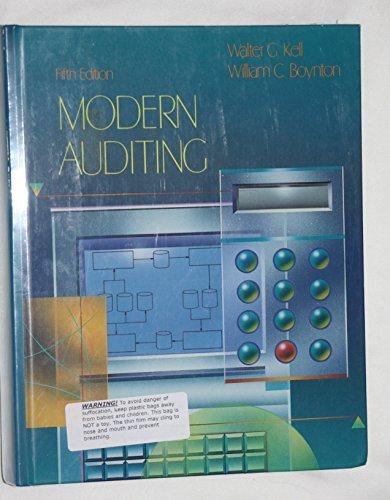After completing the interim examination of the accounts of B. Ltd, a Canadian company CA (Chartered Accountant)
Question:
After completing the interim examination of the accounts of B. Ltd, a Canadian company CA (Chartered Accountant) sent a letter to the controller, commenting on several matters which he felt required improvement.
The controller discussed the comments with his staff, then sent a reply rejecting all of CA's suggested improvements.
Excerpts from CA's letter are marked ( \(L\) ) below; excerpts from the controller's reply are marked \((R)\).
1. Petty casin:
(L) The positions of petty cash custodian and cashier should be filled by different people. At present, the cashier controls the \(\$ 500\) petty cash fund--this situation results in weak internal control because of the possibility of cash being temporarily transferred between petty cash and cash rece ipts.
(R) A \(\$ 500\) fund is too small to warrant segregation of the duties. If the cashier, for example, were involved in a lapping operation of the cash receipts, and was using the petty cash fund to cover the shortage, \(\$ 500\) would not go very far. Similarly, if part of the \(\$ 500\) were borrowed by the cashier, the amount would not be significant. The cashier is covered by our blanket bond.
2. Bank reconciliation:}
(L) The bank reconciliation should be prepared by an employee who takes no part in the regular cash receipts or disbursements functions. The reconciliation is now prepared by the bookkeeper, who also prepares the cheques and is a signing officer.
(R) We do not wish to segregate the duties with respect to the bank reconciliation and cash disbursements because the payroll cheques are included with the returned cheques. The confidential nature of the payroll amounts must be preserved.
3. Purchase orders:
(L) A purchase order when accepted by the supplier is a binding agreement to purchase the merchandise or services ordered, and should therefore include unit prices. Approximately \(75 \%\) of the purchase orders presently issued do not show unit prices.
(R) As we deal with a limited number of suppliers and as all of their prices are published in catalogues (to which the accounts payable department checks invoice prices), entering the unit price on the purchase order is an unnecessary clerical step.
4. Cuncellation of docriments:
(L) Suppliers' invoices and supporting documents should be cancelled by, or under the direct supervision of, a second cheque-signing officer. At present, vouchers are not cancelled; this cou:d lead to a fraudulent or accidental duplicate payment of an invoice.
(R) Our cash disbursement policy is that all invoices be paid within 15 days of receipt. The chance of a duplicate payment is minimal because a signing officer would notice an old invoice at the time the cheque was signed. The clerical effort to cancel the vouchers is therefore not warranted.
5. Sales invoices:
(L) Sales invoices should be pre-numbered by the printer. Without the control provided by pre-numbering, the company has no assurance that employees are not suppressing invoices and misappropriating sales proceeds.
\((R)\) We discontinued pre-numbering sales invoices because we found that the time spent controlling them was quite significant. Sales invoices in our organization can originate in a number of places; accordingly, the clerk charged with the responsibility of accounting for the numbers had a very difficult time with the many numerical sequences. This probiem was further aggravated when we switched to the present pre-billing system. The invoices are prepared before the merchandise is shipped, so the shipping department sometimes will hold an invoice for a considerable period of time awaiting receipt of the items from production or from an outside supplier.
6. Vouchers payable:
(L) The trial balance of vouchers payable should be reconciled monthly with the general ledger control account, by someone other than the accounts payable clerk. At the time of my examination there was a substantial difference between the accounts payable detail listing prepared by the accounts payable clerk and the control account in the general ledger.
\((R)\) We have a new clerk in the accounts payable department; unfortunately your examination was conducted after she had been in the position for only two weeks. Our usual practice is to have the accounts payable clerk prepare a listing of unpaid vouchers at the month-end and pass this listing to the general ledger keeper, who reconciles it to the general ledger control account. At the time of your examination the listing had been returned to the clerk as a large number of errors had become apparent-she was instructed to locate the errors in her listing as a training exercise.
Required:
For each of the six matters above, suggest what CA's position should be in his reply to the controller, supporting the position you suggest by listing factors CA would consider in drafting his reply.
Step by Step Answer:

Modern Auditing
ISBN: 9780471542834
5th Edition
Authors: Walter Gerry Kell, William C. Boynton, Richard E. Ziegler





